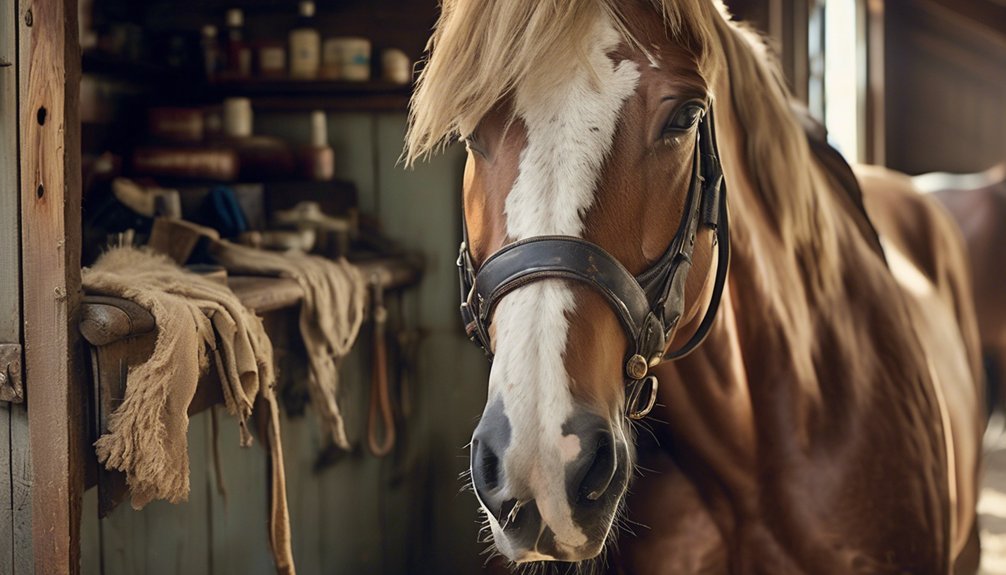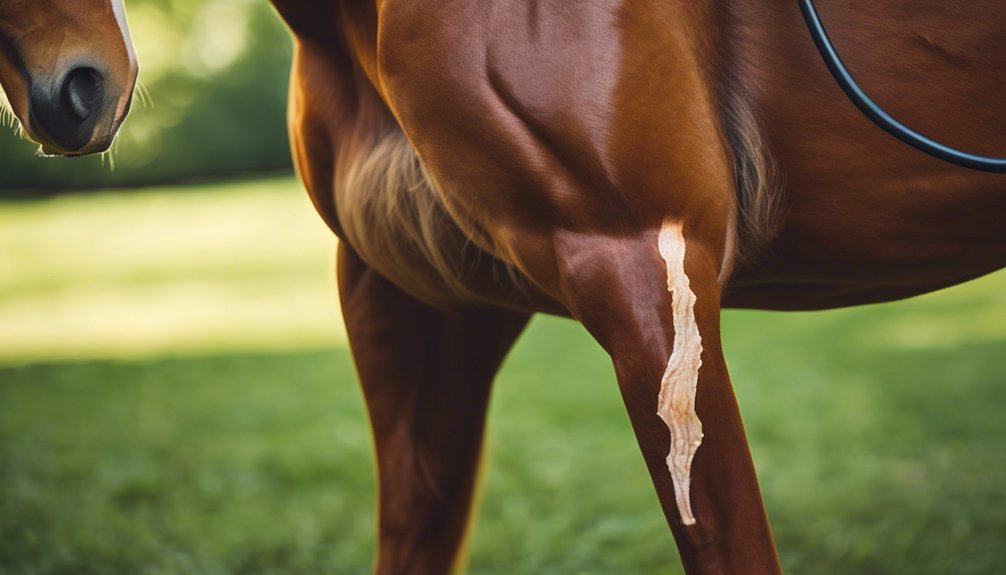
When it comes to your horse's health, skin conditions can often go unnoticed until they escalate. It's crucial to recognize the subtle symptoms like itching or hair loss early on. A careful examination can reveal underlying issues that might require intervention. Understanding how to diagnose and treat these conditions is essential, but preventative measures are equally important. Let's explore the signs and strategies to ensure your horse maintains healthy skin.
Key Takeaways
- Observe for symptoms like itchy patches, hair loss, or changes in skin texture to identify potential skin conditions early.
- Conduct thorough skin examinations and consider the horse's history to aid in accurate diagnosis.
- Utilize diagnostic techniques such as skin scrapings or cultures to identify specific pathogens causing skin issues.
- Apply appropriate treatments, including medicated shampoos and dietary supplements, tailored to the diagnosed condition for effective relief.
- Implement preventative measures like balanced nutrition, daily grooming, and hydration to maintain healthy skin and prevent future issues.
Common Horse Skin Conditions: An Overview

When you own a horse, understanding common skin conditions is crucial, as these issues can affect your horse's health and performance.
Conditions like rain rot, ringworm, and sweet itch often manifest through scab formation and hair loss, signaling underlying infections or allergies.
Rain rot, caused by bacteria, typically results in crusty patches that can lead to itching and discomfort.
Ringworm, a fungal infection, presents as circular bald patches, while sweet itch is an allergic reaction to insects, leading to severe irritation and subsequent hair loss.
Knowing these conditions helps you act quickly, ensuring your horse receives the appropriate care.
With attention and prompt treatment, you can alleviate discomfort and maintain your horse's overall well-being, fostering a trusting bond between you both.
Recognizing Symptoms of Skin Issues
Recognizing the symptoms of skin issues in horses is vital for timely intervention and effective treatment.
Pay close attention to your horse's skin; look for itchy patches that may indicate irritation or infection. You might notice your horse rubbing against objects or excessively scratching, which signals discomfort.
Hair loss is another critical symptom; observe any thinning areas or bald spots, as these could suggest underlying conditions such as allergies or parasites.
Additionally, watch for changes in skin color or texture, including swelling or scabs.
By staying vigilant and familiar with these signs, you can foster a stronger bond with your horse, ensuring their health and well-being are prioritized.
Early detection can make all the difference in treatment outcomes.
Diagnosing Skin Conditions in Horses

Diagnosing skin conditions in horses requires a systematic approach, as accurate identification is essential for effective treatment.
Start with a thorough skin examination, observing any lesions, swelling, or color changes. Pay attention to the horse's history, including previous skin issues and environmental factors.
Utilize diagnostic techniques like skin scrapings or biopsies to identify underlying infections or parasites. Culturing samples can also reveal specific pathogens.
It's vital to remain compassionate and patient, ensuring your horse feels secure during the process. Trust your instincts, and don't hesitate to consult a veterinarian for expertise.
Treatment Options for Equine Skin Problems
After identifying the specific skin condition affecting your horse, it's important to explore suitable treatment options tailored to the diagnosis.
Topical treatments, such as medicated shampoos and ointments, can effectively address localized issues like fungal infections or irritations. Always choose products that are specifically formulated for equine use, ensuring they're safe and effective.
Additionally, consider incorporating dietary supplements that promote skin health, such as omega fatty acids and biotin, to enhance overall skin condition from within. These supplements can support the immune system and improve your horse's coat quality.
Preventative Measures for Healthy Horse Skin

To maintain healthy skin in your horse, proactive measures are essential for preventing potential issues before they arise. Focus on a balanced nutrition plan, rich in vitamins and minerals, which supports skin integrity. Regular grooming techniques not only enhance your bond but also promote circulation and remove dirt, preventing skin irritations.
| Preventative Measure | Benefits |
|---|---|
| Balanced Nutrition | Supports skin health |
| Daily Grooming | Removes debris and loose hair |
| Regular Hoof Care | Prevents infections |
| Hydration | Maintains skin elasticity |
| Sun Protection | Reduces sunburn risk |
When to Seek Veterinary Assistance
Recognizing when to seek veterinary assistance is crucial for addressing skin conditions in your horse effectively.
If you notice urgent symptoms such as excessive swelling, severe itching, or open wounds, don't hesitate to contact your vet. These signs can indicate infections or allergic reactions that require immediate attention.
A professional evaluation is essential, especially if your horse shows signs of discomfort, changes in behavior, or any persistent skin issues. Early intervention can prevent more serious complications and ensure your horse's well-being.
Trust your instincts; if something feels off, it's better to err on the side of caution. Your horse deserves the best care, and timely veterinary support can make all the difference in their healing journey.
Frequently Asked Questions
Can Diet Affect My Horse's Skin Health?
Yes, diet can significantly impact your horse's skin health. Incorporating dietary supplements may help alleviate skin allergies, promoting a healthier coat and reducing irritations. It's essential to monitor their nutrition for optimal skin condition.
Are Certain Breeds More Prone to Skin Issues?
Certain breeds do show breed susceptibility to skin sensitivity. Thoroughbreds and Arabians often struggle more with skin issues. Understanding these predispositions helps you provide better care, ensuring your horse stays healthy and comfortable.
How Can I Improve My Horse's Coat Condition?
To improve your horse's coat condition, consider incorporating coat supplements into their diet, particularly during seasonal changes. These nutrients enhance shine and health, ensuring your horse looks its best while feeling great under your care.
What Are the Signs of an Allergic Reaction in Horses?
Imagine your horse's skin as a canvas; when it reacts, you'll notice signs like itchy skin, swelling, and hives. These symptoms reveal discomfort, so pay attention and consult a vet for proper care and relief.
Can Grooming Techniques Prevent Skin Problems?
Grooming techniques can indeed prevent skin problems. Using appropriate grooming tools and effective techniques, you maintain your horse's coat health, remove debris, and stimulate circulation, fostering a bond while ensuring your horse's skin stays healthy and vibrant.
Conclusion
In conclusion, keeping your horse's skin healthy is like tending a delicate garden—regular attention and care yield vibrant results. By recognizing symptoms early, accurately diagnosing issues, and implementing effective treatments, you can ensure your horse remains comfortable and thriving. Remember, prevention is key; a balanced diet and proper grooming go a long way. Don't hesitate to reach out to a veterinarian when in doubt—your horse's well-being is worth every effort.





